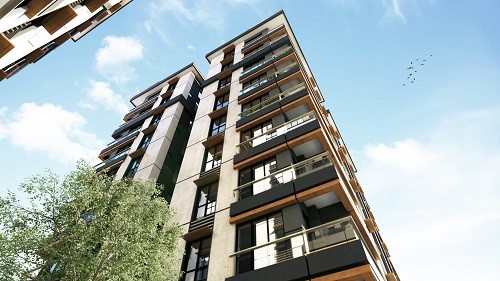The Health and Safety Executive (HSE) began its work as statutory consultee for planning applications that include a high-rise residential building in England, in August 2021.
Opinion
Fire safety design standards for tall residential buildings: room for improvement
The Health and Safety Executive (HSE) began its work as statutory consultee for planning applications that include a high-rise residential building in England, in August 2021.
Since then, our Planning Gateway One (PGO) team, which includes fire safety information assessors, has been reviewing development proposals and providing responses and comments about fire safety to local planning authorities, to inform their decisions on planning applications.
Tackling poor design for tall residential buildings right from the outset of a project’s life is a direct response to Dame Judith Hackitt’s recommendations in her Building a Safer Future – Independent Review of Building Regulations and Fire Safety report (May 2018). By amending existing planning legislation, PGO was able to be introduced as one of the first regulatory measures of the new building safety regime in England ahead of the Building Safety Act, 2022.
 Mark Wilson at HSE: "The design issues we are identifying in our role as the statutory consultee have unsettled some in the development industry."
Mark Wilson at HSE: "The design issues we are identifying in our role as the statutory consultee have unsettled some in the development industry."
In her report, Dame Judith commented that the system of building regulations and fire safety was “not fit for purpose” and culture change was required to support the delivery of safe buildings. One of the recommendations was that fire safety design in high-rise residential buildings should be considered earlier, at the planning stage, so that poor design is not ‘baked in’, before the development reaches the building regulations stage.
Concerns raised over planning applications
Our experience of assessing planning applications reflects the concerns expressed by Dame Judith. Since the PGO service began we have received over 1,000 consultation requests from local planning authorities and have raised concerns in over 50 per cent of our responses.
Feedback from local planning authorities is that they are supportive of what we’re doing. They are rightly concerned about granting planning permission for developments that we have identified as unsafe and are very reluctant to provide consent where fire safety concerns have been raised.
Common practice among some developers is that little or no consideration of fire safety is given at the planning stage and planners do not have the knowledge and expertise to be able to spot and tackle poor fire safety design. A building’s design in terms of its form and layout are largely fixed once planning permission is gained.
This often means that complex and costly fire engineered solutions are then required later to overcome these fire safety design problems. Approaching design in this way is at best sub-optimal and in some cases does not provide a satisfactory standard of fire safety. These problems affect new developments as well as refurbishments and changes of use of existing buildings.
While the debate around fire safety in tall residential buildings since the Grenfell tragedy has largely focused on cladding, the design issues we are identifying in our role as the statutory consultee go wider than that, which has unsettled some in the development industry. Feedback from some developers is they expected Planning Gateway One to be focused only on cladding and parking spots for fire appliances.
Fire risks from single staircases
However, as well as commenting on issues including smoke vents and external wall openings close to neighbouring properties and restricted or non-existent access for fire appliances, PGO comments also raise concerns on single staircases in tall residential buildings, where they represent the only means of escape for residents on upper storeys and the only access for firefighters. These can easily be made vulnerable where they connect with higher fire risk areas, such as covered car parks or waste storage facilities.
 If developers want to design tall buildings with a single staircase, we will require them to demonstrate that the staircase and escape routes are properly protected. Photograph: iStock
If developers want to design tall buildings with a single staircase, we will require them to demonstrate that the staircase and escape routes are properly protected. Photograph: iStock
If a fire breaks out in a bin store, a covered car park or basement area which is served by a single staircase, firefighters will need to use that staircase to access it. They may then need to wedge open any doors with hoses, potentially exposing the only means of escape for residents to heat, smoke, steam and fire. Relying on a single staircase inevitably means design compromises related to the convenience of connecting basements and ancillary uses to the single staircase.
Single staircases in tall buildings also pose risks for firefighter safety. Fewer access options for firefighters can lead to excessive travel distances (the distance between the door to the escape stair and the furthest flat). We are routinely raising this as a concern. Research, which is reflected in guidance, states that the maximum distance a firefighter can safely be expected to travel to get to a fire in a building is 30 metres.
We regularly find that the designs we see with single staircases, often mean that this maximum distance is not achievable. Bear in mind we are expecting firefighters carrying heavy equipment and wearing bulky gear to potentially travel through dangerously hot and smoke-bound corridors wearing breathing apparatus, after potentially climbing stairs. Some of our assessors are ex-firefighters and are keenly aware of what that feels like and the effect on a firefighter’s physiology.
We should point out that single staircases are permitted by fire standards, and they are often favoured by developers as more space can be given over to the residential and commercial areas of the building. However, if developers want to design tall buildings with a single staircase, we will require them to demonstrate that the staircase and escape routes are properly protected. Where fire engineered designs are proposed as an alternative to compliance with fire standards, we will expect them to be supported by evidence in the planning application.
HSE advice on fire safety design
Developers can use our pre-application service for advice on fire safety design. This can help them resolve issues before submitting their planning applications, and they are increasingly amending their plans based on our feedback. For example, by adding additional firefighting shafts, moving fire mains, improving fire appliance accessibility, removing firefighter hazards, and changing designs to protect escape routes and prevent fire spread to other buildings. These successes demonstrate that the PGO process is already raising design standards which ultimately will result in safer buildings.
We are using feedback from industry and others to refine the service and to get the message out to the development industry that they must do something different. We will also continue to share examples of best practice with industry to help them consider fire safety needs in planning applications.
Ultimately, however, a change in how the development industry works and thinks is required. This includes developers, architects, fire engineers, building inspectors and any other professions involved in the design, build and consenting process for high-rise residential buildings.
In particular, architects and fire engineers need to work together to apply proper fire safety design standards at the earliest point. RIBA already reflect this way of working in their ‘Plan of Work’ which sets out a staged approach to designing and developing a building. The third stage in the process is ‘Spatial Co-ordination’, at the end of which the planning application is submitted. Under this stage RIBA state that the design should be reviewed against building regulations (including fire standards) before the planning application is submitted.
There is no doubt this kind of approach would reduce consenting risks, save time, and reduce costs later. If the ‘big ticket’ design features such as the number and location of staircases, and how they interact with other uses in the building are designed in properly from the start, then subsequent regulatory stages should be less onerous.
Planning Gateway One is part of the new Building Safety Regulator (BSR) which is being set up within HSE. The BSR will become the Building Control Body for higher-risk buildings from October 2023.
Therefore, if the issues that are being raised by HSE at the planning stage are left unresolved, they will eventually be considered and dealt with by BSR at the building regulations application stage or at the point where BSR certifies the building can be occupied.
Planning Gateway One is providing a foretaste to the development industry about what a more stringent regime will look and feel like. The message to industry is clear: understand the new fire safety design landscape and respond positively to these regulatory changes. Only by doing this can industry restore confidence in their developments to residents, firefighters, regulators and the public. This is all the more important as we see the skylines of our cities and large towns prickling with tower cranes, building ever taller towers.
Mark Wilson is Operational Lead for Policy and Planning Gateway One at HSE
To keep-up-to-date with the latest news and developments from the new Building Safety Regulator sign-up to HSE's free building safety newsletter.
OPINION

The air we breathe is all our business
By Nicky O’Malley, director of corporate partnerships, Global Action Plan on 01 June 2023
Businesses have a vital role to play in improving air quality – and the UK’s Clean Air Day on 15 June is a great opportunity for companies to begin or renew their efforts in this area.

All jobs greener: why we need workforce transformation for a sustainable future
By Martin Baxter, deputy CEO, IEMA (Institute of Environmental Management & Assessment) on 01 June 2022
The shift to a green economy will create green jobs within new and emerging sectors, while those working in existing sectors will have to gain the requisite green skills to take advantage of the business value-creation opportunities that come from embedding sustainability across the whole organisation.

Preventing chemical pollution: how the UK is falling behind Europe
By Ruth Jones MP for Newport West & Shadow Minister for Agri-Innovation and Climate Adaptation on 01 June 2023


